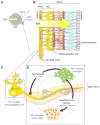Optic pathway gliomas in neurofibromatosis-1: controversies and recommendations
- PMID: 17387725
- PMCID: PMC5908242
- DOI: 10.1002/ana.21107
Optic pathway gliomas in neurofibromatosis-1: controversies and recommendations
Abstract
Optic pathway glioma (OPG), seen in 15% to 20% of individuals with neurofibromatosis type 1 (NF1), account for significant morbidity in young children with NF1. Overwhelmingly a tumor of children younger than 7 years, OPG may present in individuals with NF1 at any age. Although many OPG may remain indolent and never cause signs or symptoms, others lead to vision loss, proptosis, or precocious puberty. Because the natural history and treatment of NF1-associated OPG is different from that of sporadic OPG in individuals without NF1, a task force composed of basic scientists and clinical researchers was assembled in 1997 to propose a set of guidelines for the diagnosis and management of NF1-associated OPG. This new review highlights advances in our understanding of the pathophysiology and clinical behavior of these tumors made over the last 10 years. Controversies in both the diagnosis and management of these tumors are examined. Finally, specific evidence-based recommendations are proposed for clinicians caring for children with NF1.
Conflict of interest statement
Figures



References
-
- Alvord EC, Jr, Lofton S. Gliomas of the optic nerve or chiasm. Outcome by patients’ age, tumor site, and treatment. J Neurosurg. 1988;68(1):85–98. - PubMed
Publication types
MeSH terms
Grants and funding
LinkOut - more resources
Full Text Sources
Other Literature Sources
Research Materials
Miscellaneous

